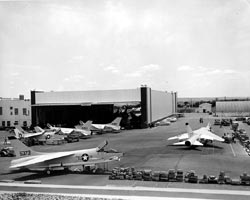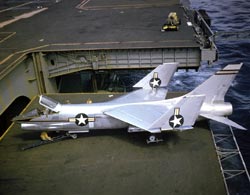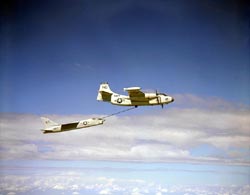|
 Significant modifications to the production aircraft were made in the powerplant, armament, and avionics systems. The Pratt and Whitney J57-P11 engine installed in the prototype aircraft was replaced with the J57-P12 in the first thirty production aircraft. The more powerful -P4A was installed in the remainder of the F8U-1 aircraft. This engine was capable of producing 10,900 pounds of static thrust at sea level and 16,600 pounds in afterburner. The armament installed in the production version of the Crusader, the “Last of the Gunfighters”, consisted of four Colt MK-12 20-mm. cannons, two each on the port and starboard lower fuselage just below the cockpit, firing out through streamlined gun ports on the sides of the air intake duct. Ammunition cans with capacity for 144 rounds per gun were installed in a compartment just aft of the cockpit, and spent shell casings were ejected into a compartment aft of the gun bays. A single AIM-9 Sidewinder missile was carried on a launcher rail mounted on each side of the upper fuselage above and aft of the gun bays and forward and below the wing leading edge. On the lower surface of the fuselage, immediately forward of the speedbrake, a rocket pack carried thirty-two 2.75-inch “Mighty Mouse” folding-fin rockets. Numerous problems with this installation surfaced during the weapons system test program. As a result, the rocket packs were disabled and never saw service during the life to the Crusader. They were eliminated during a future modification. Significant modifications to the production aircraft were made in the powerplant, armament, and avionics systems. The Pratt and Whitney J57-P11 engine installed in the prototype aircraft was replaced with the J57-P12 in the first thirty production aircraft. The more powerful -P4A was installed in the remainder of the F8U-1 aircraft. This engine was capable of producing 10,900 pounds of static thrust at sea level and 16,600 pounds in afterburner. The armament installed in the production version of the Crusader, the “Last of the Gunfighters”, consisted of four Colt MK-12 20-mm. cannons, two each on the port and starboard lower fuselage just below the cockpit, firing out through streamlined gun ports on the sides of the air intake duct. Ammunition cans with capacity for 144 rounds per gun were installed in a compartment just aft of the cockpit, and spent shell casings were ejected into a compartment aft of the gun bays. A single AIM-9 Sidewinder missile was carried on a launcher rail mounted on each side of the upper fuselage above and aft of the gun bays and forward and below the wing leading edge. On the lower surface of the fuselage, immediately forward of the speedbrake, a rocket pack carried thirty-two 2.75-inch “Mighty Mouse” folding-fin rockets. Numerous problems with this installation surfaced during the weapons system test program. As a result, the rocket packs were disabled and never saw service during the life to the Crusader. They were eliminated during a future modification.
 The two prototype aircraft were loaded with flight test instrumentation and carried virtually no mission avionic equipment. The early production F8U-1’s still had some instrumentation for such test programs as carrier suitability, weapons system test and service test — test programs that were conducted by the Navy under fleet operational conditions. The surviving aircraft from these test programs were later reconfigured to the production configuration and delivered to the fleet as operational aircraft. The true production aircraft were equipped with an AN/APG-30 gunsight-ranging radar which permitted the pilot to track a target on his cockpit radar screen. When the target was within range of the guns, and he had the target in the gunsight, he received a signal to that effect and was instructed to commence firing. The two prototype aircraft were loaded with flight test instrumentation and carried virtually no mission avionic equipment. The early production F8U-1’s still had some instrumentation for such test programs as carrier suitability, weapons system test and service test — test programs that were conducted by the Navy under fleet operational conditions. The surviving aircraft from these test programs were later reconfigured to the production configuration and delivered to the fleet as operational aircraft. The true production aircraft were equipped with an AN/APG-30 gunsight-ranging radar which permitted the pilot to track a target on his cockpit radar screen. When the target was within range of the guns, and he had the target in the gunsight, he received a signal to that effect and was instructed to commence firing.
The Crusaders were originally equipped with an ejection seat designed by Vought. During the mid-1950’s the U.S.Navy entered into an agreement with Martin-Baker, Ltd. in England to equip all Navy carrier-based aircraft with a version of their ejection seat. The seat as modified for the Crusader was designated as the F-5. By the time all of the modifications to the airframe were designed, it was decided that the in-station incorporation of the change would be made beginning with the F8U-2 model, and all of the F8U-1 and -1E aircraft would be modified by the Navy during their next depot-level maintenance period.
 At about the same time, in September 1955, the Navy decided that all carrier-based aircraft must have the capability of receiving fuel replenishment while in flight. This was accomplished by adding an air refueling probe on the starboard side of the fuselage, directly above the gun bays, aft of the cockpit. The probe was semi-submerged into a cavity, and covered with an elliptical blister which contained a hydraulically powered door. The probe was pivoted at the aft end and as it was extended by the Utility Hydraulic System, the forward tip of the probe telescoped forward until it was within the pilot’s field of vision, approximately three feet away from the side of the canopy. In this position, he could observe the probe as he flew it into the drogue on the end of the refueling hose being trailed from the tanker aircraft. At the completion of the refueling operation, the pilot retarded the throttle to slow the aircraft and disengage from the drogue, permitting him to retract the probe At about the same time, in September 1955, the Navy decided that all carrier-based aircraft must have the capability of receiving fuel replenishment while in flight. This was accomplished by adding an air refueling probe on the starboard side of the fuselage, directly above the gun bays, aft of the cockpit. The probe was semi-submerged into a cavity, and covered with an elliptical blister which contained a hydraulically powered door. The probe was pivoted at the aft end and as it was extended by the Utility Hydraulic System, the forward tip of the probe telescoped forward until it was within the pilot’s field of vision, approximately three feet away from the side of the canopy. In this position, he could observe the probe as he flew it into the drogue on the end of the refueling hose being trailed from the tanker aircraft. At the completion of the refueling operation, the pilot retarded the throttle to slow the aircraft and disengage from the drogue, permitting him to retract the probe
More F8U:
XF8U-1 Innovative Systems
XF8U-1 In the Cockpit
A New Aircraft and a New Corporation
F8U-1 and F8U-1E Production Aircraft Changes
Life Extension
Loss of XF8U-3 Contract and a New Challenge
Last Flight - December 1999
|

 Significant modifications to the production aircraft were made in the powerplant, armament, and avionics systems. The Pratt and Whitney J57-P11 engine installed in the prototype aircraft was replaced with the J57-P12 in the first thirty production aircraft. The more powerful -P4A was installed in the remainder of the F8U-1 aircraft. This engine was capable of producing 10,900 pounds of static thrust at sea level and 16,600 pounds in afterburner. The armament installed in the production version of the Crusader, the “Last of the Gunfighters”, consisted of four Colt MK-12 20-mm. cannons, two each on the port and starboard lower fuselage just below the cockpit, firing out through streamlined gun ports on the sides of the air intake duct. Ammunition cans with capacity for 144 rounds per gun were installed in a compartment just aft of the cockpit, and spent shell casings were ejected into a compartment aft of the gun bays. A single AIM-9 Sidewinder missile was carried on a launcher rail mounted on each side of the upper fuselage above and aft of the gun bays and forward and below the wing leading edge. On the lower surface of the fuselage, immediately forward of the speedbrake, a rocket pack carried thirty-two 2.75-inch “Mighty Mouse” folding-fin rockets. Numerous problems with this installation surfaced during the weapons system test program. As a result, the rocket packs were disabled and never saw service during the life to the Crusader. They were eliminated during a future modification.
Significant modifications to the production aircraft were made in the powerplant, armament, and avionics systems. The Pratt and Whitney J57-P11 engine installed in the prototype aircraft was replaced with the J57-P12 in the first thirty production aircraft. The more powerful -P4A was installed in the remainder of the F8U-1 aircraft. This engine was capable of producing 10,900 pounds of static thrust at sea level and 16,600 pounds in afterburner. The armament installed in the production version of the Crusader, the “Last of the Gunfighters”, consisted of four Colt MK-12 20-mm. cannons, two each on the port and starboard lower fuselage just below the cockpit, firing out through streamlined gun ports on the sides of the air intake duct. Ammunition cans with capacity for 144 rounds per gun were installed in a compartment just aft of the cockpit, and spent shell casings were ejected into a compartment aft of the gun bays. A single AIM-9 Sidewinder missile was carried on a launcher rail mounted on each side of the upper fuselage above and aft of the gun bays and forward and below the wing leading edge. On the lower surface of the fuselage, immediately forward of the speedbrake, a rocket pack carried thirty-two 2.75-inch “Mighty Mouse” folding-fin rockets. Numerous problems with this installation surfaced during the weapons system test program. As a result, the rocket packs were disabled and never saw service during the life to the Crusader. They were eliminated during a future modification.
 The two prototype aircraft were loaded with flight test instrumentation and carried virtually no mission avionic equipment. The early production F8U-1’s still had some instrumentation for such test programs as carrier suitability, weapons system test and service test — test programs that were conducted by the Navy under fleet operational conditions. The surviving aircraft from these test programs were later reconfigured to the production configuration and delivered to the fleet as operational aircraft. The true production aircraft were equipped with an AN/APG-30 gunsight-ranging radar which permitted the pilot to track a target on his cockpit radar screen. When the target was within range of the guns, and he had the target in the gunsight, he received a signal to that effect and was instructed to commence firing.
The two prototype aircraft were loaded with flight test instrumentation and carried virtually no mission avionic equipment. The early production F8U-1’s still had some instrumentation for such test programs as carrier suitability, weapons system test and service test — test programs that were conducted by the Navy under fleet operational conditions. The surviving aircraft from these test programs were later reconfigured to the production configuration and delivered to the fleet as operational aircraft. The true production aircraft were equipped with an AN/APG-30 gunsight-ranging radar which permitted the pilot to track a target on his cockpit radar screen. When the target was within range of the guns, and he had the target in the gunsight, he received a signal to that effect and was instructed to commence firing.
 At about the same time, in September 1955, the Navy decided that all carrier-based aircraft must have the capability of receiving fuel replenishment while in flight. This was accomplished by adding an air refueling probe on the starboard side of the fuselage, directly above the gun bays, aft of the cockpit. The probe was semi-submerged into a cavity, and covered with an elliptical blister which contained a hydraulically powered door. The probe was pivoted at the aft end and as it was extended by the Utility Hydraulic System, the forward tip of the probe telescoped forward until it was within the pilot’s field of vision, approximately three feet away from the side of the canopy. In this position, he could observe the probe as he flew it into the drogue on the end of the refueling hose being trailed from the tanker aircraft. At the completion of the refueling operation, the pilot retarded the throttle to slow the aircraft and disengage from the drogue, permitting him to retract the probe
At about the same time, in September 1955, the Navy decided that all carrier-based aircraft must have the capability of receiving fuel replenishment while in flight. This was accomplished by adding an air refueling probe on the starboard side of the fuselage, directly above the gun bays, aft of the cockpit. The probe was semi-submerged into a cavity, and covered with an elliptical blister which contained a hydraulically powered door. The probe was pivoted at the aft end and as it was extended by the Utility Hydraulic System, the forward tip of the probe telescoped forward until it was within the pilot’s field of vision, approximately three feet away from the side of the canopy. In this position, he could observe the probe as he flew it into the drogue on the end of the refueling hose being trailed from the tanker aircraft. At the completion of the refueling operation, the pilot retarded the throttle to slow the aircraft and disengage from the drogue, permitting him to retract the probe